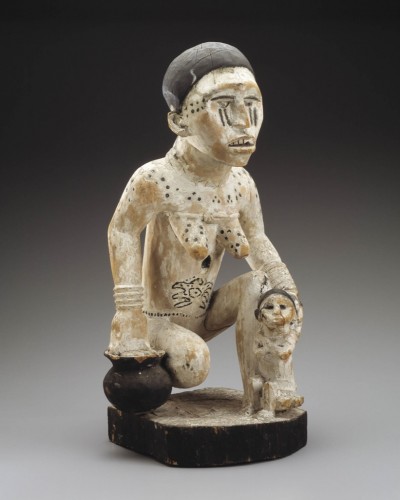A Cosby Exhibit at the Smithsonian
November 21, 2014

This portrait of Bill and Camille Cosby by Simmie Knox is part of a collection of African American Art loaned to the Smithsonian
THE Smithsonian Museum of African Art embarrassingly has a new exhibit from the collection of Camille and Bill Cosby, who are so much in the news for allegations that Bill drugged and raped white aspiring actresses, quite an ironic twist on the message of oppression that comes through here and there in the exhibit catalogue materials. The exhibit, titled “Conversations: African and African American Artwork in Dialogue,” displays African works alongside those by African Americans.
The superiority of the American pieces is striking, judging from the works displayed by the Smithsonian online. The African artworks, such as the sculptures below which are from the 19th and 20th centuries, are brutal, ugly and primitive. The African American pieces, not including the ridiculous portrait of Camille and Bill above, show in some cases a relatively high level of artistic transcendence. Thus despite the accompanying instructional material, that speaks of enslavement and racial injustice in America, the exhibit suggests that blacks were liberated and elevated when they came into contact with Western civilization.

Kongo artist, Angola, Democratic Republic of the Congo, Republic of the Congo;
Late 19th, early 20th century
— Comments —
Dan R. writes:
I am very unschooled when it comes to art, but when you described the portrait of the Cosbys as “ridiculous” I had to take a second look at it. Lo and behold, it appears that the artist made a very elementary mistake: Bill Cosby’s right and left legs are all out of proportion to each other, with one seeming to be considerably longer than the other. The perspective seems quite out of whack, too…even looking at his feet. Have I missed something? If not, the obvious question raises itself: how does a very flawed work such as this make it to the Smithsonian?
Laura writes:
In answer to your question, it’s African American. And it’s a portrait of the Cosby’s.
It just seems very corny and amateurish, as if they are not real, but those cut-out figures that people stick their faces in at fairs and amusement parks, and Camille appears to be white, which is weird in this kind of exhibit.
As I said, there are some better works, such as this romantic landscape by Robert Duncanson:
And this naive 1830 portrait of a Baltimore matron by Joshua Johnston:
But then again, on the negative side, there’s this American sculpture, Maternity, by Elizabeth Catlett, which appears to be right out of the Our Bodies, Our Selves collective, except this woman is giving birth to a monkey. I guess that’s the Inner Ape.
Notice the striking difference between these two 20th-century busts below, the first African and the second African American. The second one is so much more human despite the blankness of the eyes. Much African art has a chilling, demonic quality that is apparent in this first bust, as well as in the sculptures, if that’s what they are, near the top of the page.
Paul T. writes:






